Address
304 North Cardinal
St. Dorchester Center, MA 02124
Work Hours
Monday to Friday: 7AM - 7PM
Weekend: 10AM - 5PM
Address
304 North Cardinal
St. Dorchester Center, MA 02124
Work Hours
Monday to Friday: 7AM - 7PM
Weekend: 10AM - 5PM
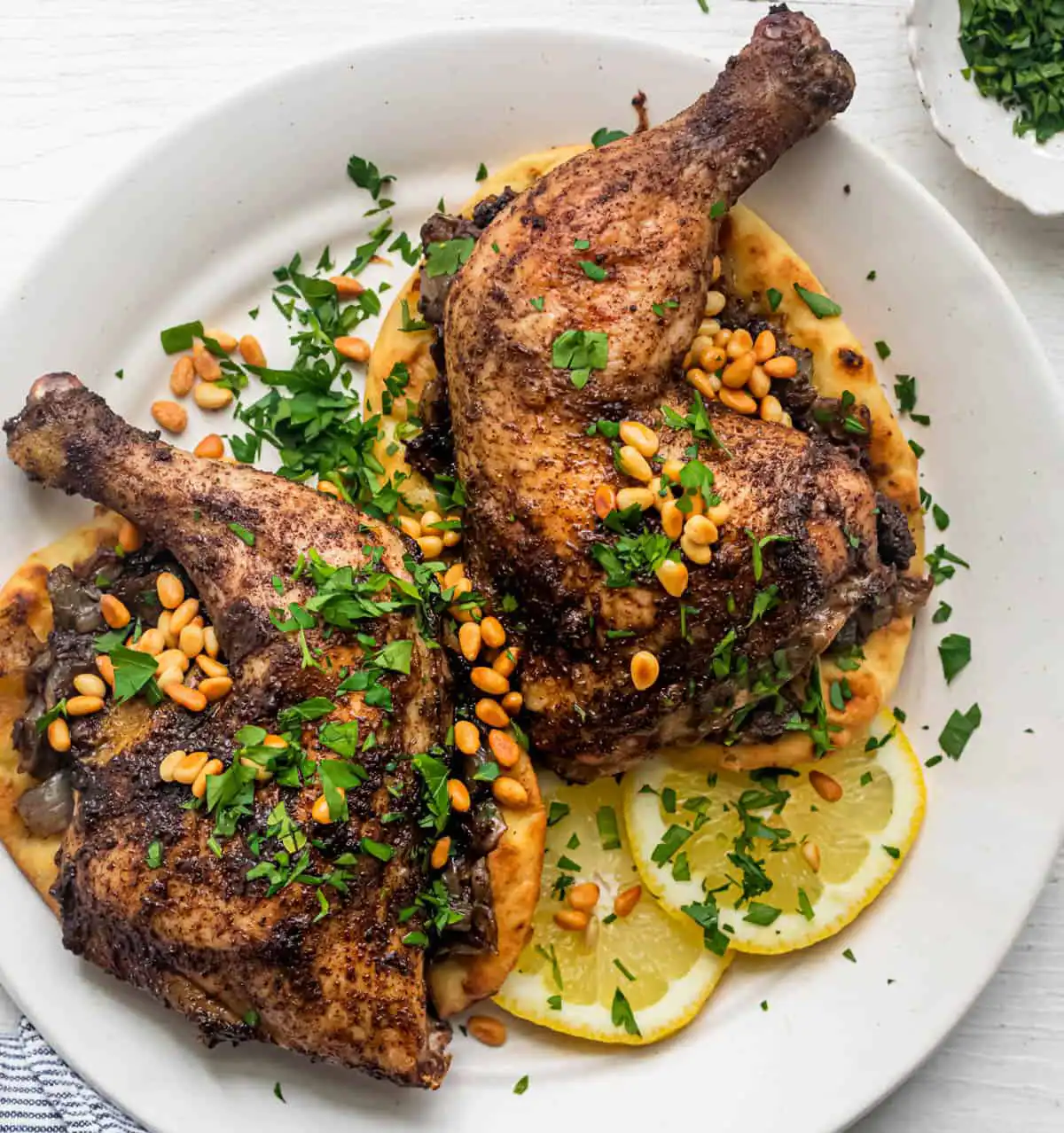
In Palestine, food is not merely sustenance; it is the heart of the culture. It permeates every aspect of Palestinian existence, from everyday life to festive occasions. It’s about sharing quality moments with family and creating memorable experiences that stand out. Beyond the well-known classics such as hummus and falafel, a visit to Palestinian cuisine reveals a treasure trove of diverse and delectable dishes, from tantalizing rice and meat creations to delectable Palestinian sweets and pastries.
As you explore this article, you’ll quickly discover that the diverse and exquisite world of Palestinian cuisine is reason enough to plan a trip to Palestine. So, without further ado, join us on a culinary journey through this list of 21 Palestinian dishes. They are sure to leave a lasting impression on your taste buds!

When embarking on a culinary journey in Palestine, you must try Maqluba. Its name, quite literally, means “upside-down,” fittingly describing how locals present this dish. Maqluba is not confined to Palestinian borders; it holds a beloved and unique place in Syria, Lebanon, Jordan, and Iraq as well.
This Palestinian culinary gem is an ideal choice for lunch, offering a harmonious blend of flavors and textures. It comprises rice, an assortment of vegetables, typically potatoes, tomatoes, and cauliflower, an array of aromatic spices, and tender meat, often lamb or chicken. The magic happens when you artfully layer all these elements in a copper pot. Start with the meat at the bottom, followed by the vegetables and rice.
The pièce de résistance is when local Palestinians perform the captivating culinary ritual of flipping the copper pot upside down, giving birth to the dish’s namesake, “maqluba.”
To elevate your Maqluba experience, consider pairing it with a refreshing cucumber and tomato salad and a side of yogurt. This combination of soft, simmered meat and flavorful rice is truly enchanting, ensuring a delightful culinary journey that will captivate your taste buds. Furthermore, Maqluba is a true testament to the artistry of Palestinian cuisine.

Mansaf, while Jordan’s national pride, has carved out a special place in the hearts and tables of Palestinians. It’s not merely a dish; it’s a cultural emblem. When you encounter Palestinians gathered around a table, their left hands discreetly behind their backs, it’s a surefire sign that Mansaf is the star of the show.
Mansaf’s origins are humble, with meat, often lamb or camel, and a broth or ghee served alongside bread as its foundational elements. However, it was in 1920s Jordan that Mansaf gained popularity and saw the introduction of white rice into the dish.
This classic delicacy is a harmonious union of rice and tender roasted lamb slices marinated in yogurt, creating a delectable, aromatic symphony. Furthermore, at its core, you’ll discover “shark,” a type of thin bread reminiscent of tortillas, which serves as the vessel to soak up the rich sauce. Additionally, a crown of almonds and pine nuts adorns the Mansaf as a final flourish, adding a delightful crunch and depth of flavor.
The name “Mansaf” draws its essence from the notion of a “huge dish” or a “big tray,” underscoring its association with grand gatherings that span from joyful weddings to somber funerals. Additionally, Mansaf transcends mere sustenance; it’s a cultural embodiment, a tradition of togetherness and celebration, and a cherished legacy that unites the hearts and palates of Jordan and Palestine.
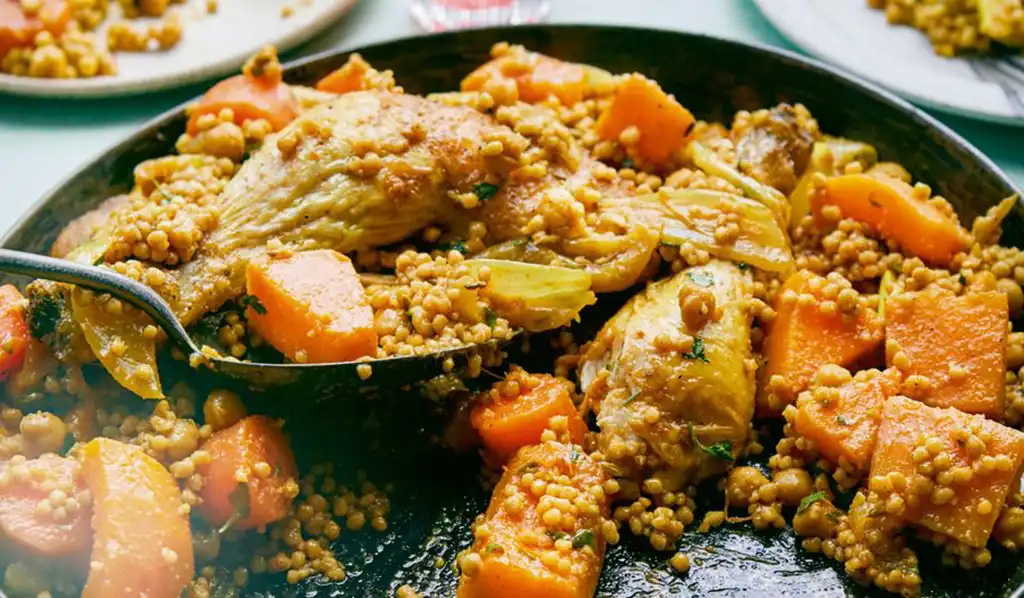
In the vibrant tapestry of Palestinian cuisine, Maftoul emerges as a brilliant and must-try dish. Often referred to as “enormous couscous,” it is a culinary experience that promises to envelop your senses with its rich and hearty flavors, especially comforting on a chilly night.
Maftoul is traditionally crafted by the skilled hands of local Palestinians, particularly the adept rural women. The process typically involves the sautéing of finely chopped onions and peppers, followed by a simmer in a savory, aromatic broth. Key to the dish’s depth and richness are the warm, fragrant spices that infuse every morsel.
Serving Maftoul is a straightforward yet rewarding affair. It often entails ladling a savory soup over roasted bone-in chicken pieces or succulent, tender portions of beef and lamb. However, for those who prefer a vegetarian rendition, a mild tomato broth and an assortment of vegetables can be artfully combined to create a delightful and wholesome dish.
Maftoul is not merely a meal; it’s a journey through the heart of Palestinian culture and a testament to the culinary expertise of its makers. Moreover, its substantial couscous and flavorful broth remind us that Palestinian hospitality’s warmth extends beyond just chilly nights to every moment at the table.
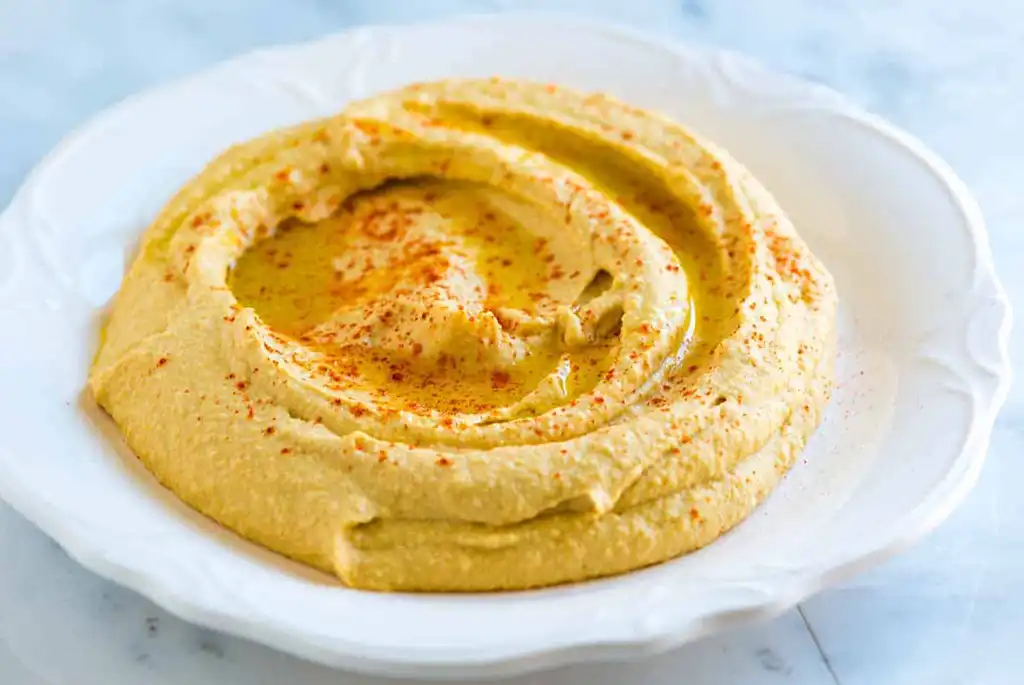
In Palestine, the hummus experience is a revelation that goes beyond what you find in pre-packaged versions. Furthermore, crafted with the utmost freshness, this beloved dip shines in the world of Palestinian cuisine. The recipe involves meticulously drying and simmering skinless chickpeas with tahini, lemon juice, and a touch of garlic.
Hummus, with its simple yet divine preparation, is a flavor-packed and nutrient-rich delight. Boasting high fiber and protein content, it’s a healthy choice that requires less than 10 minutes to create. An added bonus is that you can savor it without any reservations, as traditionally-made hummus is entirely plant-based and vegan-friendly.
Drizzle olive oil generously when serving. Enjoy with fresh veggies or warm flat breads, savoring Palestinian cuisine’s unforgettable harmony of warmth and tanginess. Hummus is a cherished symbol of culinary artistry.
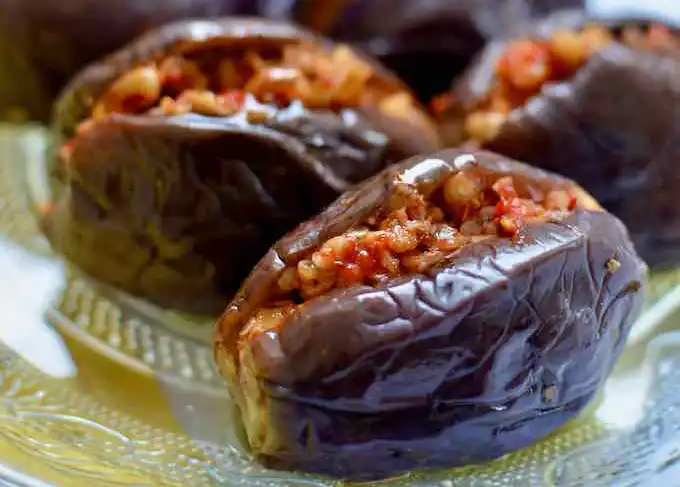
If you’re in the mood for a delectable vegan Palestinian dish, Makdous, or oil-cured eggplants, is a captivating option. Traditionally, small baby eggplants are filled with roasted red peppers, garlic, and walnuts. They’re marinated in rich olive oil.
While Makdous is adored in Palestine, its appeal extends across the Levant region, with Iraq and other neighboring countries savoring this culinary gem.
After preparation, tangy eggplants are jarred for a quick snack. Additionally, they enhance sandwiches and wraps, adding convenience and versatility. Furthermore, Makdous showcases Palestinian cuisine’s artistry, providing a satisfying vegan option without sacrificing tradition or taste.

An ancient proverb wisely asserts, “A hungry man would sell his soul for a meal of mujadara,” and once you’ve had the pleasure of savoring this dish, you’ll wholeheartedly concur.
Mujadara, a harmonious blend of lentils, bulgur wheat, and fresh salads, is a vegan masterpiece that deserves an esteemed spot on your “Palestinian foods” list. Additionally, it’s not just a beloved dish; it’s one of the healthiest and oldest traditional culinary treasures in the country.
The allure of mujadara extends far beyond Palestine, resonating with the taste buds of those in other Eastern Arab nations. Depending on the region, you may come across varied names such as Majadra, Mejadra, Mudardara, and more.
To complete your mujadara experience, a generous topping of fried onions is essential, and it’s best enjoyed alongside plain yogurt and soft flatbread. Who could resist a plate featuring a flavorful base of rice, cooked lentils, and a crown of savory, crispy onions? Indeed, mujadara is a timeless comfort food that transcends mere sustenance, offering a glimpse into the heart and soul of Palestinian culinary traditions.
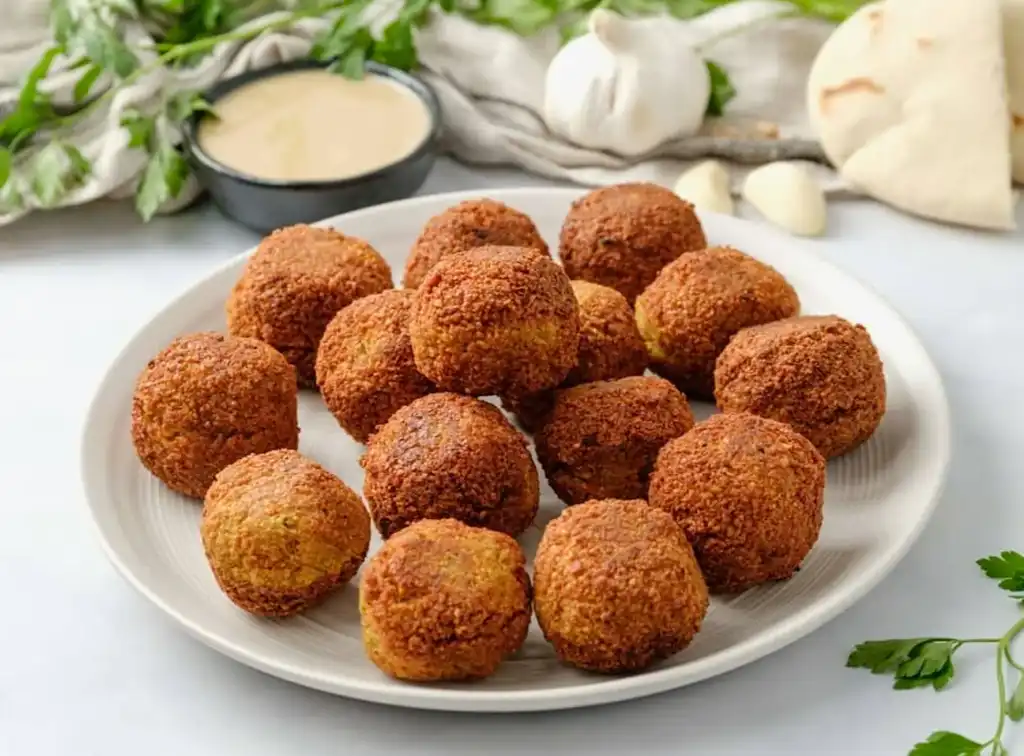
Falafel holds a cherished place as a Palestinian culinary icon. This renowned dish has a fascinating history, originating as street food crafted by Yemenite immigrants in the 1950s, seeking to make a living. Since then, the recipe has transcended borders, gracing the food menus of both Israeli and Palestinian cuisines.
A typical Falafel experience involves an array of pickled vegetables, generously dipped in creamy hummus and served within warm pita or flatbread sandwiches. However, the traditional Palestinian Falafel is a revelation in itself, presenting spicy, deep-fried balls crafted from ground chickpeas. On occasion, fava beans may be used to replace chickpeas, adding a delightful twist to this beloved dish.
In Palestine, preparing falafel at home is a rarity; the true joy lies in acquiring freshly-fried falafel from the multitude of eateries that adorn the towns. Missing out on this extraordinary street food would indeed be a significant loss during your visit to Palestine. Falafel is not just a dish; it’s a journey through the heart of Palestinian culture, a sensory celebration that encapsulates the essence of the region’s vibrant street food traditions.
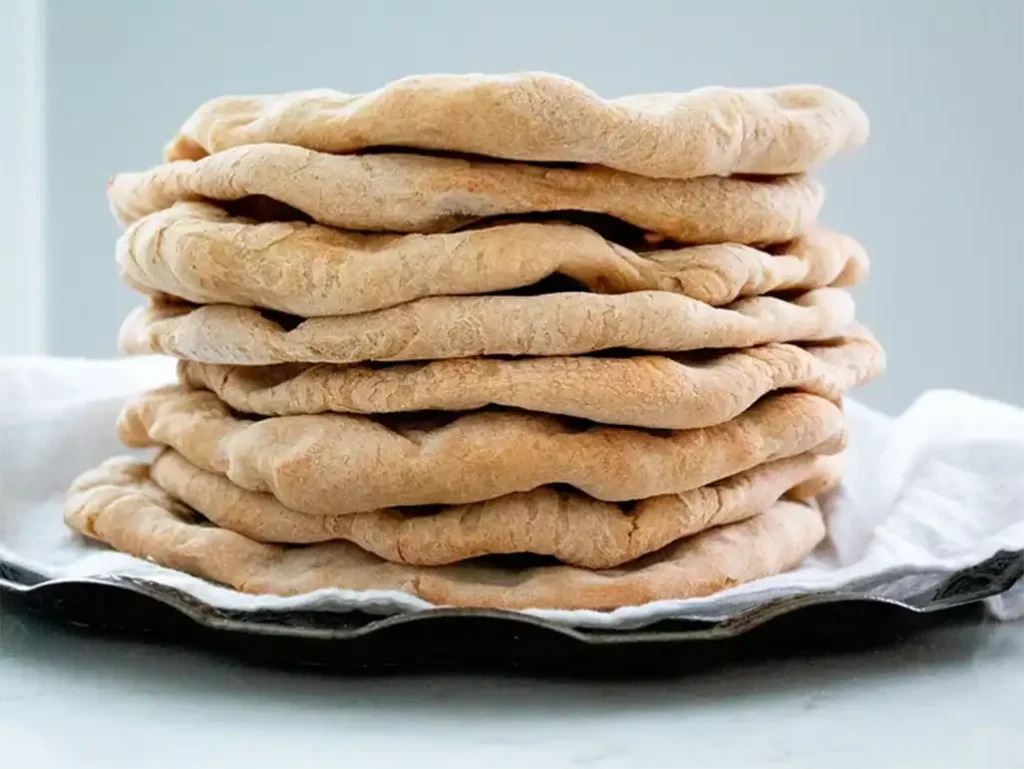
Step into the heart of Palestinian cuisine and savor the marvel of Taboon, an enormous circular flatbread baked to perfection in a distinctive clay oven. Additionally, this remarkable creation boasts a delightful contrast of textures – a crunchy and chewy exterior, adorned with airy pockmarks that grace its surface.
Taboon showcases its versatility through a medley of variations, each dictated by the filling within. Moreover, within the Palestinian borders, it’s not uncommon to encounter Taboon filled with a savory spinach and onion mixture, a sweet blend of raisins and pine nuts, delectable cheese curds, or the classic onion concoction.
Beyond Palestine, you’ll find similar flatbreads. In Israel, Laffa, and in Jerusalem, it’s known as Ashtanur. These counterparts each offer a unique take on this cherished culinary tradition.
To experience Taboon like a local, you can dip it in creamy hummus or indulge in it smothered with caramelized onions, just as people do in the beloved dish Masakhan. Furthermore, Taboon’s versatility doesn’t stop; it makes an ideal vessel for wrapping and filling, similar to pita bread.
As delicious as freshly-baked Taboon is, it’s essential to note that its freshness is fleeting; it’s at its best within two days, even when stored in an airtight container. Whether in Palestinian villages or bustling city streets, Taboon is a testament to the heart and soul of Palestinian cuisine, a symbol of togetherness, and a flavorful journey that transcends mere sustenance.

Prepare your taste buds for the exquisite delight that is Knafeh, a traditional Palestinian dessert that weaves a culinary tapestry of semolina dough, a buttery filling, and mild white cheese. What sets Knafeh apart from other pastries is its luscious, caramelized layer of honey syrup, adding an unforgettable dimension of sweetness.
Hailing from Nablus, Knafeh exudes an elegant charm when crowned with pistachios and served warm. The result is a symphony of flavors and textures that dance on your palate, harmonizing rich and sweet with soft and crunchy in every delectable bite.
Knafeh’s appeal transcends borders, with its popularity extending to Libya, Egypt, Syria, and numerous other Middle Eastern, Balkan, and North African nations. In these regions, the dessert takes on different names, such as Kanafeh, Kunafeh, or Konafi.
For an authentic Knafeh experience, consider venturing to Nablus. Here, you can seek out these grand, circular platters of golden pastry, each one a testament to the artistry of Palestinian dessert-making. Additionally, Knafeh is not just a dessert; it’s a cultural emblem, a sweet celebration, and a culinary journey that invites you to explore the captivating flavors of Palestine and beyond.
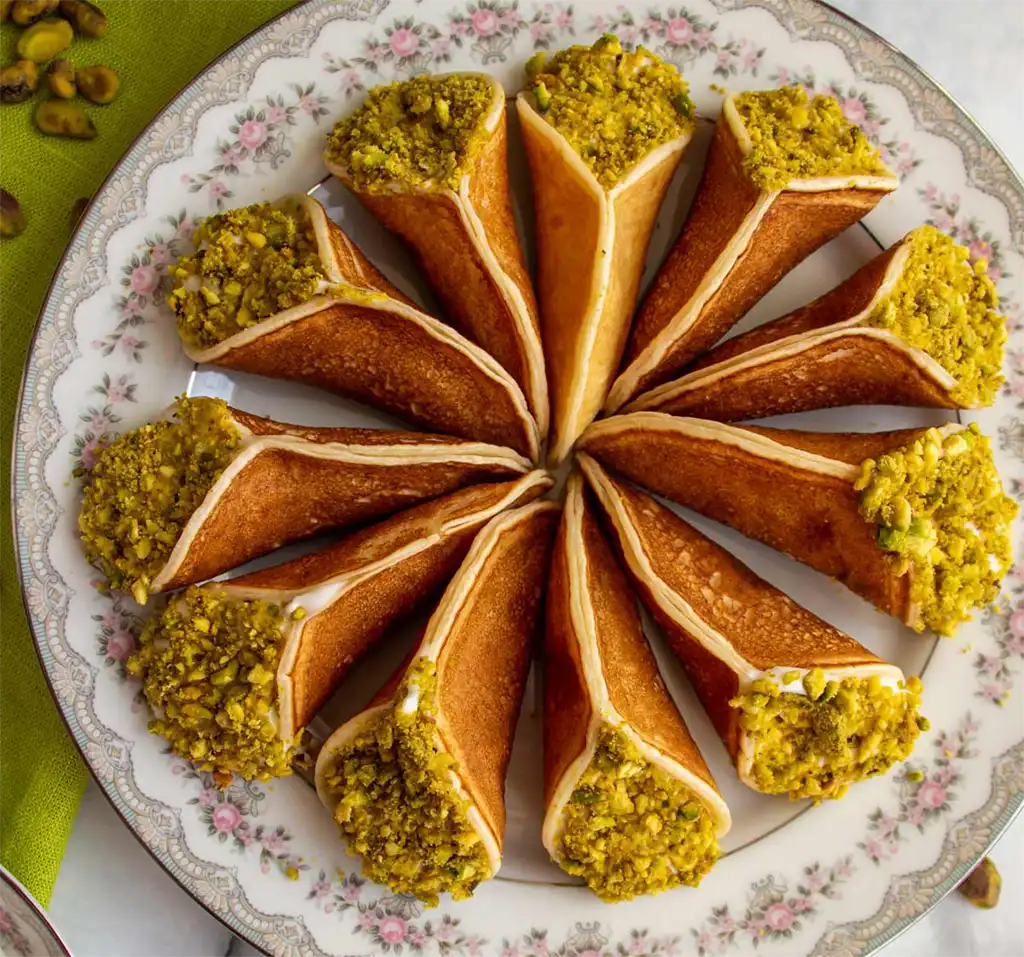
Qatayef, a beloved delight in Palestinian cuisine, is a culinary masterpiece that demands attention.
These small, folded pancakes are a testament to the culinary artistry that thrives in this region, presenting a symphony of flavors and textures that will undoubtedly captivate your palate.
Qatayef is a delectable creation that embodies the essence of Palestinian cooking. These tender pancakes, folded with care, house a tantalizing mixture of cheese, nuts, and aromatic spices. This combination culminates in a sensory explosion with every bite. Furthermore, to complete the experience, they are generously drizzled with a sweet, fragrant syrup that elevates their taste to new heights.
For those fortunate enough to find themselves in Bethlehem, the Mahsiry Qatayef store on Hebron Road is a must-visit destination. Here, you can savor these legendary pastries crafted with love and precision. However, if your culinary journey takes you beyond Bethlehem, head to Nazareth and seek out Deran al-Seraya in the Old City to embark on a memorable Qatayef experience.
What sets Qatayef apart is its remarkable versatility. You can bake them to a golden perfection, fry them for a delightful crispness, or savor them in their unadorned form. Their adaptability extends to flavors as well, where you can indulge in sweet or savory variations. Whether you choose the open or closed version, each bite of Qatayef promises to deliver the perfect amalgamation of sticky sweetness and crispy textures, leaving your palate in a state of pure bliss.
Qatayef is not just a dessert; it’s a journey through the heart of Palestinian culinary heritage, a symbol of tradition and togetherness. It’s a testament to the artistry of Palestinian cooking and a culinary experience that will etch itself into your memory. Furthermore, Qatayef is a must-try, a sweet embrace of Palestinian culture and flavor.
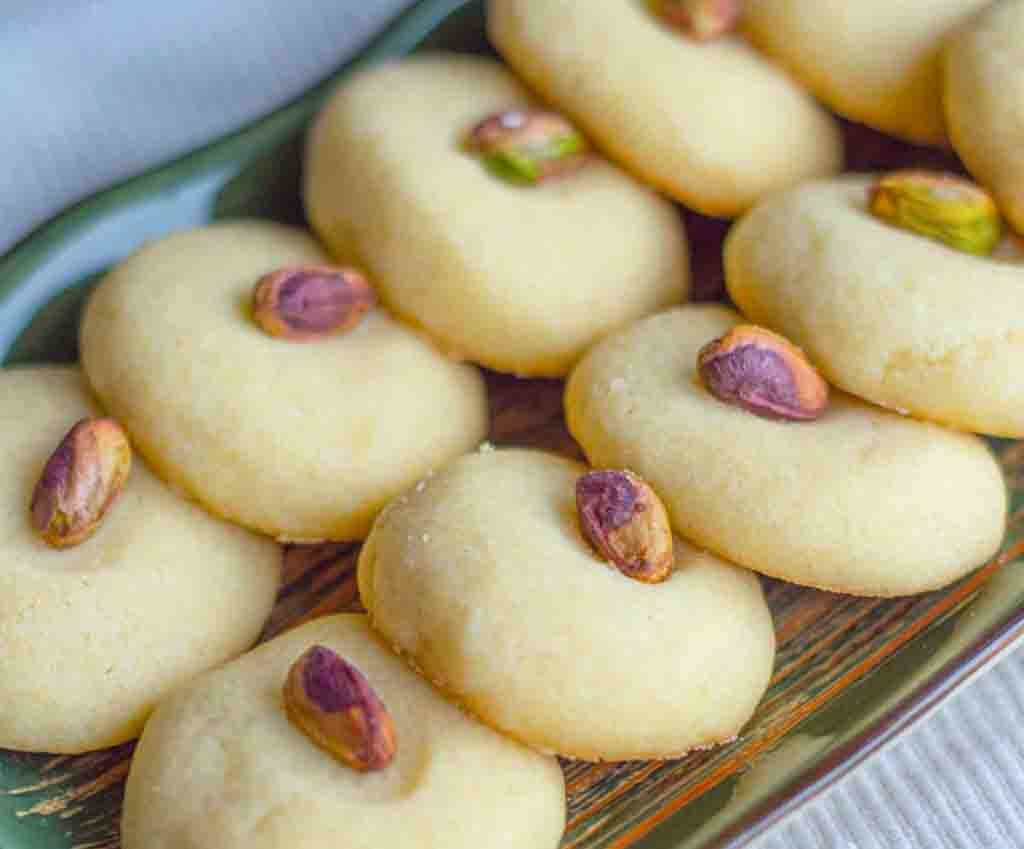
Ghraybeh, the beloved Palestinian almond shortbread, is a culinary gem that beckons to pastry lovers. Furthermore, crafted with meticulous care and an infusion of ground almonds, these cookies offer a creamy texture and a rich, buttery flavor that’s simply irresistible.
For local Palestinians, Ghraybeh holds a special place, evoking cherished memories of childhood and a connection to their culinary heritage. These cookies are not just a treat; they are a portal to the past, a taste of tradition that carries stories and nostalgia within each bite.
Visitors to Palestine often find themselves receiving these delightful cookies as gifts during Ramadan and Eid, making them a cherished symbol of festive occasions. One remarkable attribute of Ghraybeh is its longevity; when properly packed and stored at room temperature, they remain fresh for an extended period, allowing you to savor their delightful flavor over time.
To add a touch of festivity, a gentle sprinkle of powdered sugar over these almond shortbreads is the perfect finishing touch. Ghraybeh is not merely a cookie; it’s a cultural emblem, a bridge to the past, and a delightful representation of Palestinian hospitality and warmth.
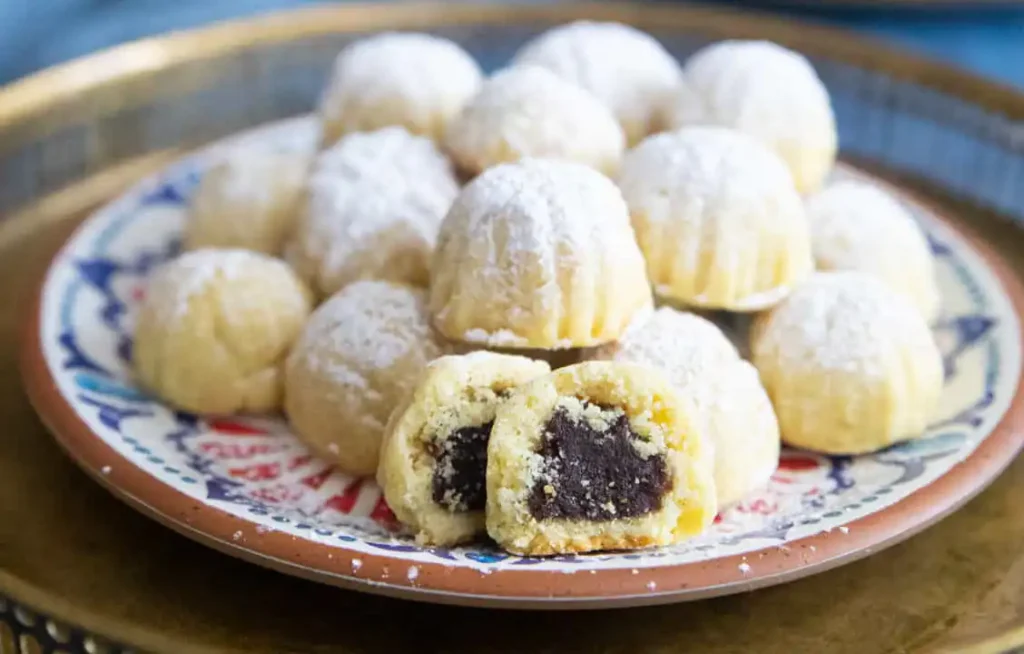
Ghraybeh celebrates ground almonds, while Ma’amoul cookies stand out with date filling. They are buttery shortbread cookies filled with figs, dates, walnuts, or almonds, offering delightful surprises.
Ma’amoul cookies charm with diverse shapes, reflecting the maker’s preferences. Furthermore, bakers hand-decorate them or use “tabe” wooden molds for intricate patterns, adding an extra layer of charm to these treats.
Ma’amoul’s appeal transcends its appearance. The magic happens when you take that first bite, and the cookie crumbles to reveal the sweet, velvety date filling within. The taste is a harmony of textures and flavors that will surely steal your heart. These Palestinian treats come with the added assurance of minimal added sugar, as the natural sweetness of dates takes center stage.
Ma’amoul is more than a cookie; it’s a cultural emblem and symbol of artistry. These cookies, with sweet date-filled centers and buttery, crumbly exteriors, represent Palestinian culinary tradition and warm hospitality.
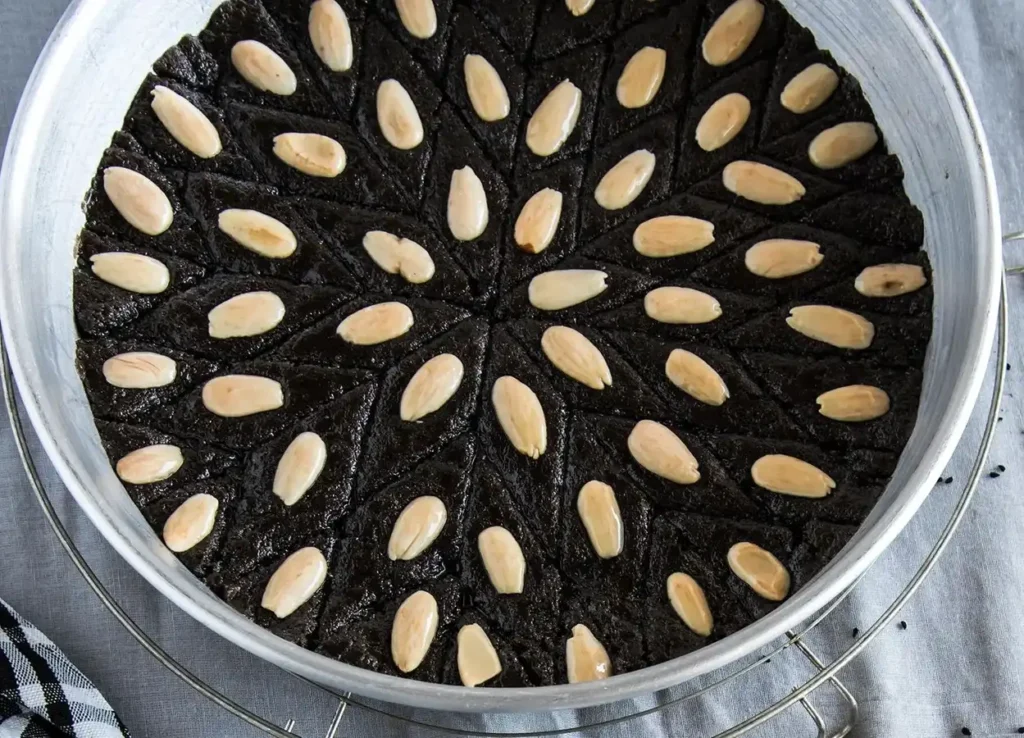
Within the rich tapestry of Palestinian cuisine, Qizha stands out as a truly distinctive delight. This black seed paste, derived from crushed nigella seeds, is unlike any other culinary offering. Its flavor profile is characterized by a pungent and robust essence, with intriguing hints of sweetness and a surprising minty, oniony aftertaste.
Qizha’s versatility knows no bounds, as it can be paired with other condiments like tahini, elevating its culinary appeal. Additionally, it finds its way into pies and pastries, adding a layer of complexity and depth to these dishes.
One intriguing aspect of Qizha is its status as a cherished traditional remedy. In Nablus, it’s common to find the elderly consuming a daily spoonful of this specialty. This practice is believed to help ward off illnesses and preserve health, reflecting the age-old wisdom of Palestinian culinary traditions.
Qizha is more than food; it’s a culinary curiosity, showcasing Palestine’s intriguing flavors. Its robust, unique taste and historical significance make it a culinary journey in Palestinian cuisine.
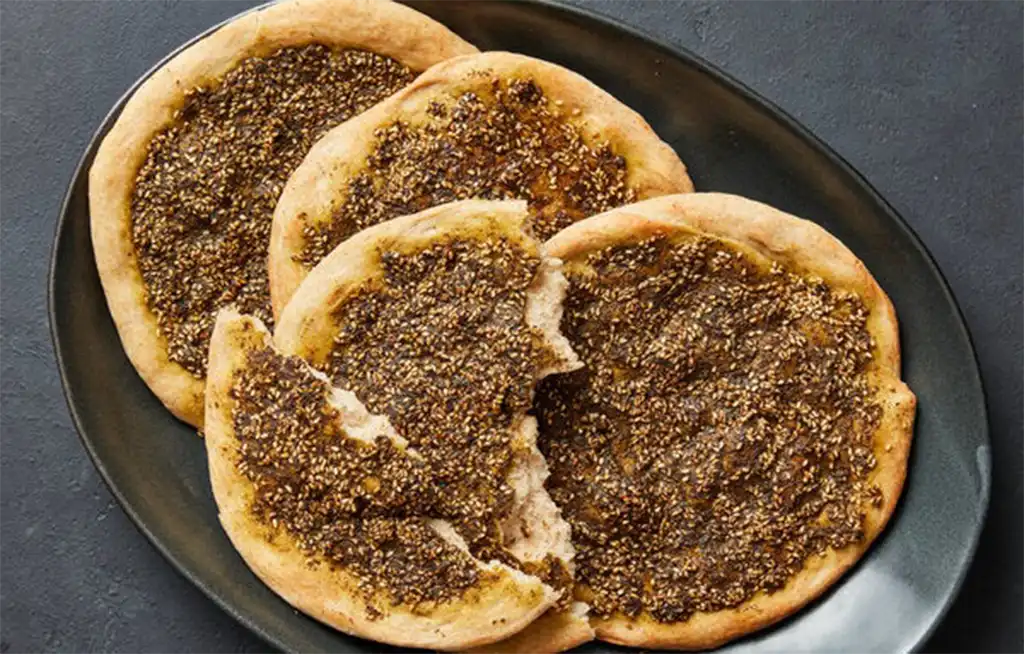
Za’atar, an essential component of Palestinian cuisine, is a culinary gem known for its astonishing versatility. This aromatic spice blend flavors various dishes, even drinks and flu remedies. Additionally, Za’atar is not just spices; it’s the wild thyme infusing this blend with unique character.
Za’atar’s herbs offer antioxidants, making it a tasty and nourishing spice blend. Additionally, Palestinian tradition suggests eating a Za’atar sandwich before a test to boost concentration and alertness, a practice commonly observed among Palestinian children.
Za’atar embodies the heart and soul of Palestinian culinary traditions. It adds layers of flavor to dishes, inviting you to explore the diverse and vibrant flavors of the region. It’s more than taste; it’s a symbol of Palestinian culture. Culinary traditions are intertwined with everyday life, providing sustenance for the body, mind, and spirit.
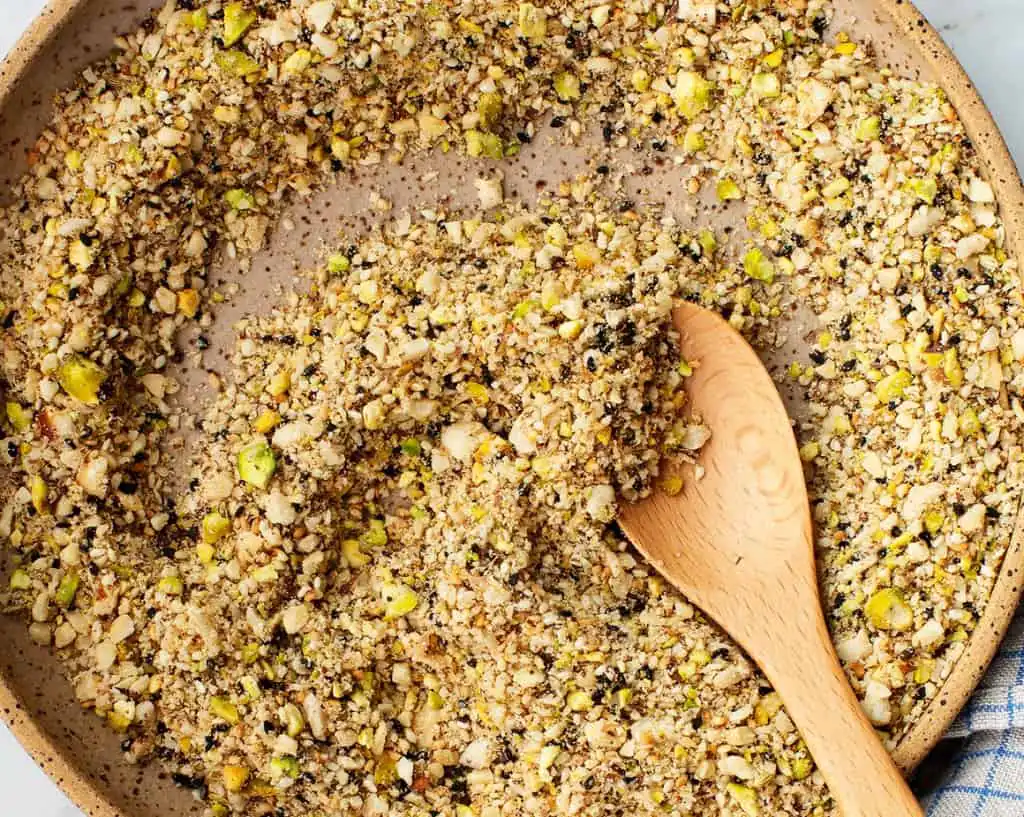
Dukkah, also known as Duqqa or Du’a, is another delightful Palestinian condiment that’s a treasure trove of flavor. While its ingredients may vary depending on your location, in Palestine, it typically features a base of wheat berries and legumes.
You can find premade versions of Dukkah in charming paper cones at the vibrant spice markets scattered throughout Palestine. Savoring this renowned spice is an experience to behold. Begin by dipping your bread in smooth, golden olive oil and then into the Dukkah.
As your taste buds encounter this enticing blend, prepare for a burst of flavors. Dukkah combines spices, olive oil, and bread for a sensory journey in Palestinian cuisine. Moreover, it elevates ordinary into extraordinary, embodying Palestinian culinary traditions.
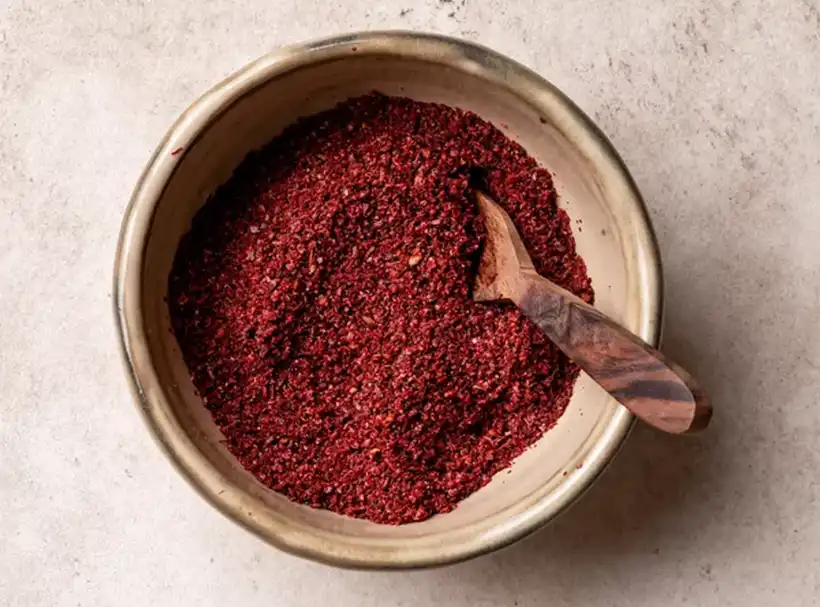
Sprouting from the picturesque hills of Palestine, sumac is a culinary gem renowned for its unique tartness. This versatile spice is ideal for marinating poultry or beef, imparting a distinctive flavor that elevates dishes to new heights. Additionally, if you’re a fan of Musakhan, you’ll recognize the prominent presence of sumac in this traditional Palestinian dish’s delightful taste.
Sumac is derived from mature red berries and transformed into a coarse powder. This imparts a flavor profile that is tart, fruity, and astringent. Additionally, it offers a tantalizing zest reminiscent of lemon but with a milder sourness.
For those seeking to make the most of sumac’s delightful attributes, a valuable tip is to sprinkle it over meat dishes just moments before serving. This ensures that its bold flavor shines through, enhancing the dish with a burst of zest. Sumac isn’t limited to savory dishes; it shines in salads, adding a fresh, zesty taste that elevates the culinary experience.
Sumac, a Palestinian hillside treasure, symbolizes culinary heritage, tradition, and flavor, enriching the region’s culinary tapestry. It’s a reminder that even the smallest ingredients can have a profound impact on the richness of Palestinian cuisine.
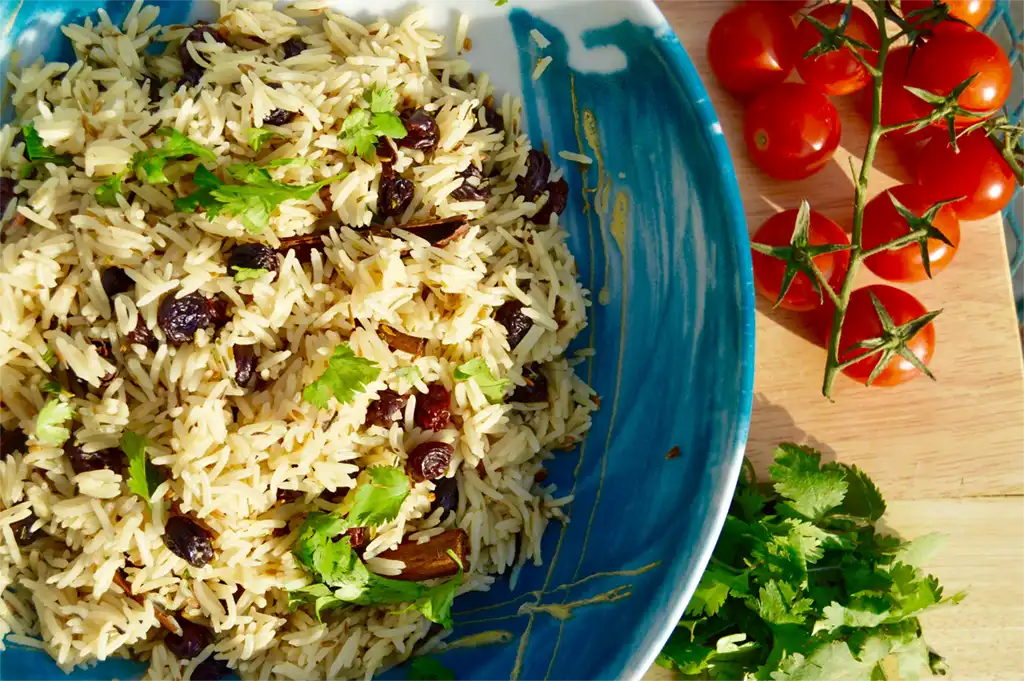
Rain Rice, a cherished Palestinian dish, is a testament to the region’s culinary heritage. This delightful creation weaves together a captivating combination of fragrant jasmine rice, sultanas, and aromatic cinnamon.
The process starts with cooking rice, sultanas, and cinnamon flakes. Once the grains absorb flavors and swell, remove the pan from heat. To get the right texture, cover it with a towel, letting it absorb any remaining moisture gracefully.
In minutes, Rain Rice, or arroz de lluvia, is ready. It’s served with lemon slices and yogurt for a delightful mix of flavors and textures, a true culinary delight.
Rain Rice is more than food; it celebrates Palestinian tradition, hospitality, and culture. It showcases Palestinian cuisine’s artistry, inviting you to explore captivating Palestinian flavors.
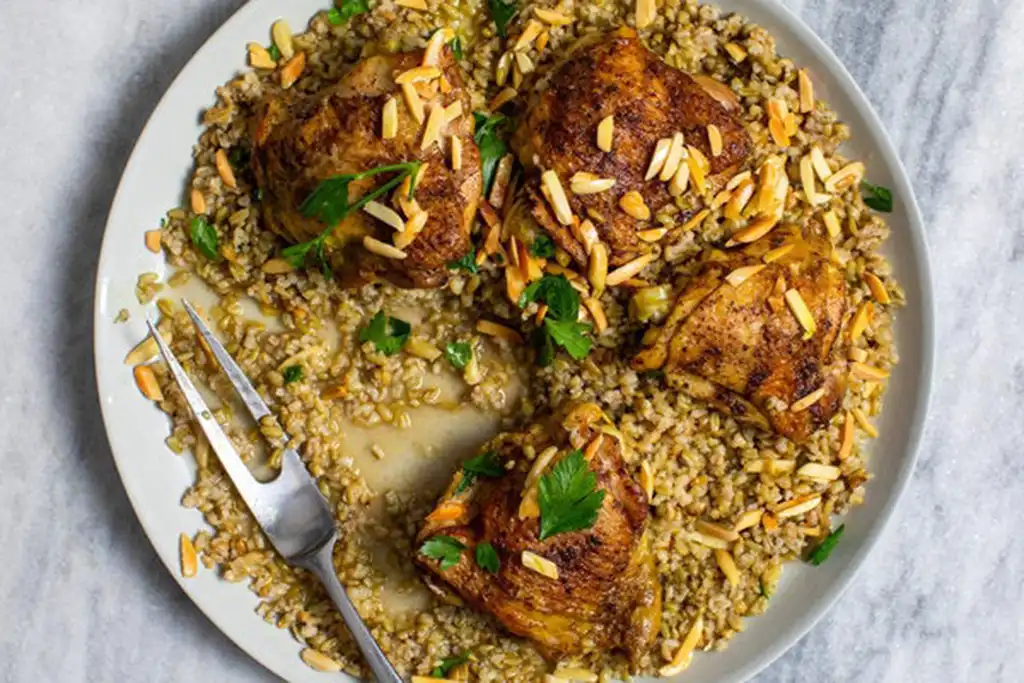
In the tapestry of Palestinian culinary treasures, Freekeh stands out as a cherished gem, especially for those seeking a classic meat-based dish. However, this roasted green durum wheat variety is a culinary star in its own right.
What distinguishes Freekeh are its unique smoky flavors that impart a captivating depth to the dish. While it’s typically categorized as a meat-based offering, Freekeh takes center stage due to its exceptional qualities.
Beyond its smoky and savory notes, Freekeh emerges as a nutritional powerhouse akin to other whole grains like bulgur. It has more protein than brown rice, fewer calories and carbs than quinoa, and is a good option for blood sugar control due to its lower glycemic index. However, it’s important to note that Freekeh does contain gluten, unlike grains such as quinoa and wheat berries.
Freekeh, in Palestinian cooking, fills aubergines and vine leaves in the “mahshi” method. It’s paired with chicken or enjoyed alone for its unique qualities. This dish delights the taste buds and is a great Middle Eastern dinner choice.
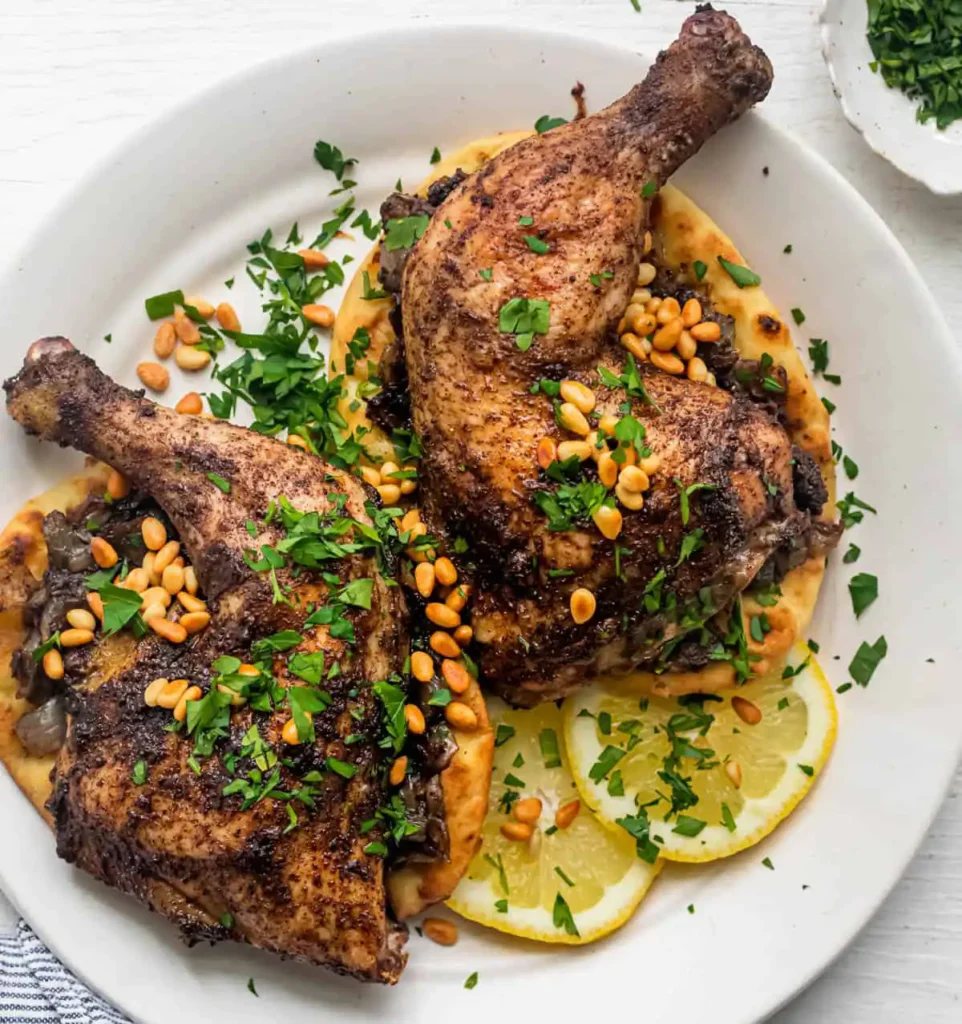
Musakhan blends tradition with tasty ingredients like olive oil, sumac, caramelized onions, and roasted chicken on warm flatbread called taboon. While its core elements remain consistent, each Palestinian family infuses a unique twist. They poach and roast the chicken for tenderness, often garnishing it with almonds or pine nuts for crunch and richness.
In modern times, Musakhan’s versatility inspires creative presentations. It can be enjoyed as wraps, transformed into pizzas, or even incorporated into lasagna. This adaptability makes it a must-try for both tradition enthusiasts and flavor innovators alike.
Shish Barak, a Middle Eastern delight, delivers ultimate comfort. These lamb-filled dumplings in a yogurt-based sauce make a perfect dinner choice and freeze well. Additionally, to enhance your experience, season your fillings with modest spices like cumin, cilantro, and shatta. These choices harmonize with the creamy goodness of the yogurt sauce.

When it comes to Middle Eastern and Palestinian cuisine, Shish Barak is a dish that beckons with irresistible allure. These handmade lamb dumplings are nothing short of a culinary masterpiece, elevating comfort food to a new level.
Shish Barak presents a delightful marriage of flavors and textures, with the lamb-filled dumplings swimming in a luscious yogurt-based sauce. Furthermore, this dish is not only a feast for the taste buds but also a brilliant dinner option for those who appreciate the flavors of the Middle East.
One of the remarkable attributes of Shish Barak is its convenience. It freezes exceptionally well, allowing you to prepare two batches and store one for later. This culinary foresight ensures that you always have a delicious and convenient supper at your fingertips.
When crafting Shish Barak, a judicious approach to seasoning is key. By opting for milder spices such as cumin, cilantro, and shatta (chili paste), you ensure a harmonious blend of flavors. These spices allow the meat to shine while allowing the yogurt sauce to take the spotlight. Consequently, Shish Barak becomes a culinary gem that invites you to savor the soul-soothing comfort of Middle Eastern cuisine.
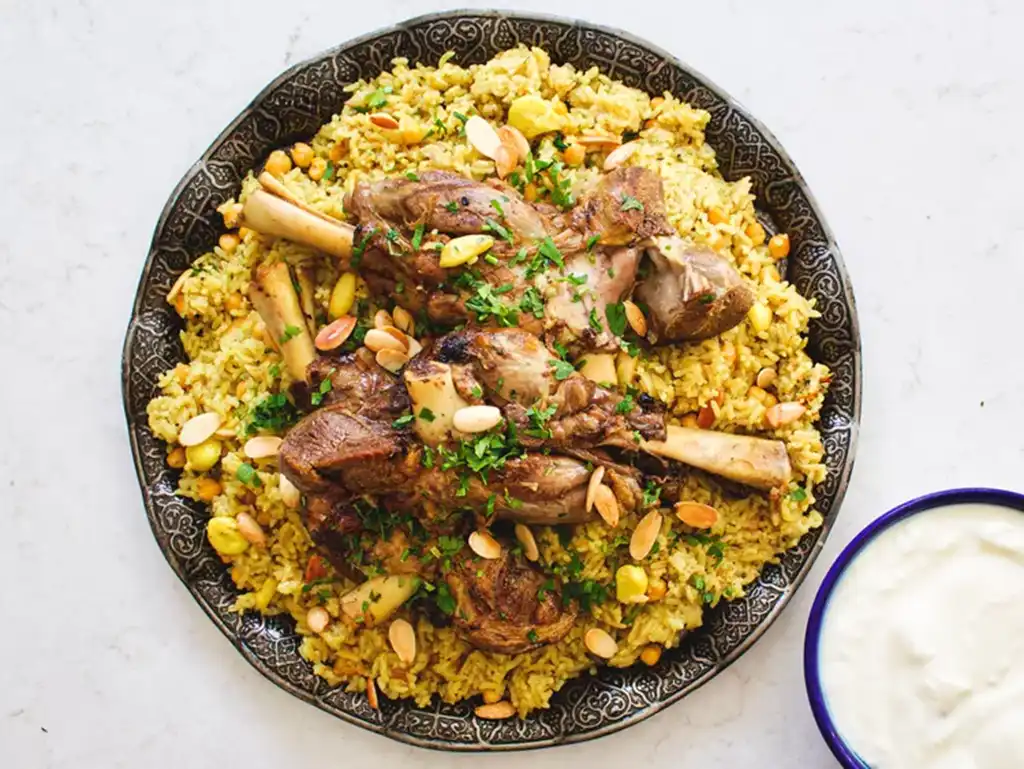
One Palestinian meat dish for your must-try list is Qidreh – a traditional dish from Hebron. In case you don’t know, Hebron is the second holiest city in Palestine, just after Jerusalem.
Qidreh comprises meat (typically lamb and chicken) cooked with chickpeas and rice. What makes Qidreh unique is its flavorful and spicy broth brimming with condiments like cumin, allspice, and turmeric.
Traditionally, people prepare Qidreh in a large copper or brass pot and cook in a communal wood-fired oven. This cooking process gives Qidreh a unique taste.
Palestinians love having Qidreh at social gatherings of friends and family. It’s a year-round favorite, perfect for holidays like Ramadan and Eid, and a comforting winter treat.
Serve the dish with a cool Arabic salad and plain yogurt as a side for extra enjoyment.